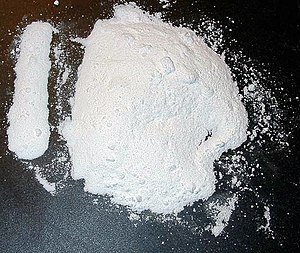Baking powder
Baking powder is a dry chemical leavening agent used to make baked foods lighter and less dense. Baking powder works by making a reaction between an acid and a base. This produces carbon dioxide bubbles to make the mixture light. Baking powder was invented by the English chemist Alfred Bird (1811–1878) in 1843.

It is used when the food should not taste of yeast,[1] or when the mixture is not elastic enough to hold bubbles for very long.[2] But sometimes, it has a metallic taste.[3] Because carbon dioxide is made faster by baking powder than yeast, breads made with it are called quick breads.
Most baking powders are made up of an alkaline (usually baking soda), one or two acid salts, and a starch (cornstarch or sometimes potato starch). Baking soda is where the carbon dioxide comes from,[4] and the acid releases it, like this:[5]
- NaHCO3 + H+ → Na+ + CO2 + H2O
Bird was quickly followed by Henry Jones (1812 – 12 July 1891) who invented self-raising flour in 1845.
References change
- ↑ Matz, Samuel A. (1992). Bakery Technology and Engineering (3 ed.). Springer. p. 54. ISBN 9780442308551. Retrieved 2009-08-12.
- ↑ McGee, Harold (2004). On Food and Cooking (revised ed.). Scribner-Simon & Schuster. p. 533. ISBN 9781416556374. Retrieved 2009-08-12.
- ↑ Nast, Condé (2015-08-11). "The Mysteries of Aluminum-Free Baking Powder". Epicurious. Retrieved 2021-08-07.
- ↑ "Chemical Leaveners, Lallemand Baking Update, Vol. 1 No. 12, 1996" (PDF). Lallemand Inc. Archived from the original (PDF) on 2006-10-14. Retrieved 2009-03-05.
- ↑ A.J. Bent, ed. (1997). The technology of cake making (6 ed.). Springer. p. 102. ISBN 9780751403497. Retrieved 2009-08-12.